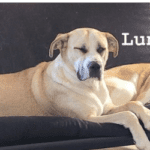Since we have been in lock down, our dogs have grown accustomed to their favorite humans being around 24/7! And while that has been wonderful for cuddles and bonding, it also creates some new concerns.
Unfortunately, as people return to work or are simply leaving the house more often, we are seeing an increase in separation anxiety in our pets. If your dog is showing signs of stress, here are some helpful tips to transition your pup back to more independent living.
If you are looking to understand if your dog is displaying signs of anxiety, please see this blog post. For guidance on how long you can leave your dog at home by themselves, please see this resource.
1) Ease Your Dog into More Alone Time

Even if you are still home the majority of the day, go ahead and start introducing some alone time. Even if it is for short periods, time apart will help your dog to transition more smoothly when you are gone for longer periods of time in the future. Here are a few easy examples:
- Close the door when you are using the bathroom
- Take out the trash or go outside alone for brief times
- If you are working from home, keep your dog out of the room for an hour or two each day
The earlier you can reintroduce alone time to your dog, the better! If they learn from a young age that they have nothing to worry about when they are left alone, they are less likely to have separation anxiety as an older dog!
2) Do Not Give In When Your Dog is Whining or Crying When You Are Practicing Alone Time
While it may break your heart a bit, when you are practicing leaving your dog alone for short periods of time, do not re-enter the room, or let them into your space if they are whining or barking. It could reinforce their behavior if you give them exactly what they want (to be with you at all times!). Instead, wait until they have calmed down for a period, and then praise them with a calm tone of voice, and some gentle pets.
3) Exercise Before You Leave

If you know you are going to be gone for longer periods of time, before you go, try to get in a longer walk, or throw the ball around to burn some extra energy. If they are worn out, they are more likely to take a good long nap afterwards. It is helpful to provide a calm, safe space for them to snooze when you are gone. Try setting up a room with a dog bed and their favorite blankets and toys.
While they still might be dreaming about their best bud, they won’t be awake and actively missing you.
4) Do Not Make a Big Deal Out of Leaving or Returning Home
When you leave, do not make a big show of it. If you make a big deal about your departure, if may be more likely your dog will become anxious about being left behind.
A big happy greeting is always wonderful when you return, but try to greet them calmly to avoid overreactions. Once they have calmed down, then you can shower them with love. Waiting until they have calmed down helps to reduce the emotion of you leaving and returning. Over time, hopefully they will become more and more comfortable that you will be back before they know it.
5) Distract Your Dog with a Toy or Treats Before You Go!
If you give your dog something like a food puzzle, a long lasting chew, or a toy they love to play with before you go, it will provide a distraction, and help to
 keep them mentally stimulated and occupied while you are gone. Plus…if they are busy chewing on something you want them to chew on, they are less likely to chew on furniture or your favorite pair of shoes!
keep them mentally stimulated and occupied while you are gone. Plus…if they are busy chewing on something you want them to chew on, they are less likely to chew on furniture or your favorite pair of shoes!
Also, by providing a positive experience, and giving them something they enjoy when you leave, it helps to teach them that your leaving isn’t something to dread.
Note: Make sure to only give out treats when you are leaving, not when you are arriving home. If you provide treats when you get home, it will only make your dog more eager and anxious for you to get home.




